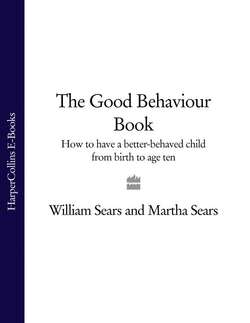Читать книгу The Good Behaviour Book: How to have a better-behaved child from birth to age ten - Martha Sears - Страница 23
martha and matthew – how they got connected
ОглавлениеWe love reading teacher’s reports about our nine-year-old Matthew: “He’s so focused.” “He’s so well-behaved.” Our friends give us compliments about Matthew: “He’s such a joy to have around.” “He’s a good influence on my son.” During a toy squabble between Matthew and a friend, an observing parent said, “Matthew is incredibly sensitive to other children.” A new mother watching Martha discipline a conflict between Matthew and a sibling remarked, “How did you know what to do?”
How did Matthew come to be this way? Is he afraid of being punished, or is he just naturally “good”? Where did his self-control come from? How can one subtle look from Martha pull him back from the brink of trouble? How did this pair get so well connected? The story of disciplining Matthew goes all the way back to the day of his birth.
Immediately after birth Martha gathered up Matthew and cuddled him to her breast. As Matthew lay skin-to-skin, no longer enclosed in the warmth of her womb, he found a new place where he fit. As he fed from Martha’s breast, snuggled against her chest, nested in her arms, he found a new “womb”. When he opened his eyes, he found Martha’s eyes gazing adoringly into his. Matthew arrived knowing where he belonged and feeling that this was a warm and comfortable place to be. Matthew felt right. Though no longer connected by the cord, the pair stayed connected by the hormonal high of new motherhood and the ability of a newly born baby to make his needs known. No distance – physical or emotional – developed between them. During the day Martha held Matthew close to her or wore him in a baby sling, fed him on cue, and responded sensitively to his needs. At night they slept side by side, Martha providing security and comfort to Matthew.
This connection, the beginning of discipline, continued through Matthew’s baby days. When Matthew cried, Martha responded, and Matthew learned that his distress was followed by comfort. Because Martha gave Matthew a consistent response, Matthew learned to trust that his mother was responsive to him. Never mind that Martha did not always give the “perfect” response (Matthew may have wanted a change of scenery, but Martha offered to feed him). The important point is that she responded. Even though this was our sixth baby, Martha had to learn to read Matthew as an individual. With time and patience and through hundreds of rehearsals, Matthew and Martha worked at their communication until they got it right most of the time. As time progressed, Martha learned to anticipate Matthew’s needs. When a grimace appeared, a cry was sure to follow. So she responded to the grimace before a panic cry had a chance to develop. Mother and baby were comfortable and happy together.
As I watched this pair grow together (and did what I could to support them), I noticed that while Martha’s initial responses to Matthew’s cues involved some trial and error, they quickly became more intuitive. There was harmony to their relationship, a flow of cue giving and caregiving between a little person with big needs and a mother motivated to meet those needs. This led to an inner feeling of well-being that is characteristic of a connected mother-baby pair. The same sparkle was in the eyes of both mother and son. We enjoyed being with him, and he enjoyed being with us. Because Matthew was connected, he felt valued – the beginning of a child’s self-worth, the basis of disciplined behaviour. Matthew’s smiles and contentment made Martha feel valued as well, the beginning of parental self-confidence.
I saw a mutual sensitivity develop between Matthew and Martha. When Matthew was upset, Martha knew what he needed, almost as if she could get inside his mind. Martha seemed to feel what Matthew was feeling and vice versa. When Matthew’s behaviour deteriorated or when he was not feeling well, her sensitivity went up a notch. She clicked into motherly overdrive, with a higher level of acceptance and a higher level of giving. Matthew also became sensitive to Martha. When she was having a bad day, Matthew became less sparkly and more clingy. By the time Matthew was a year old, we were well on our way to having a disciplined child.We knew our child, and Matthew felt right.
Once we put the initial investment of time and energy into getting to know Matthew, meeting his needs, and anticipating his behaviour, his entry into toddlerhood did not worry us. When Matthew drifted into undesirable behaviour, it was not difficult to rechannel his actions. He was willing to be redirected because he knew we respected his need to hatch. His sense of self was blossoming. (Bill’s connection to Matthew is described in Chapter 6, “Fathers as Disciplinarians”.)
